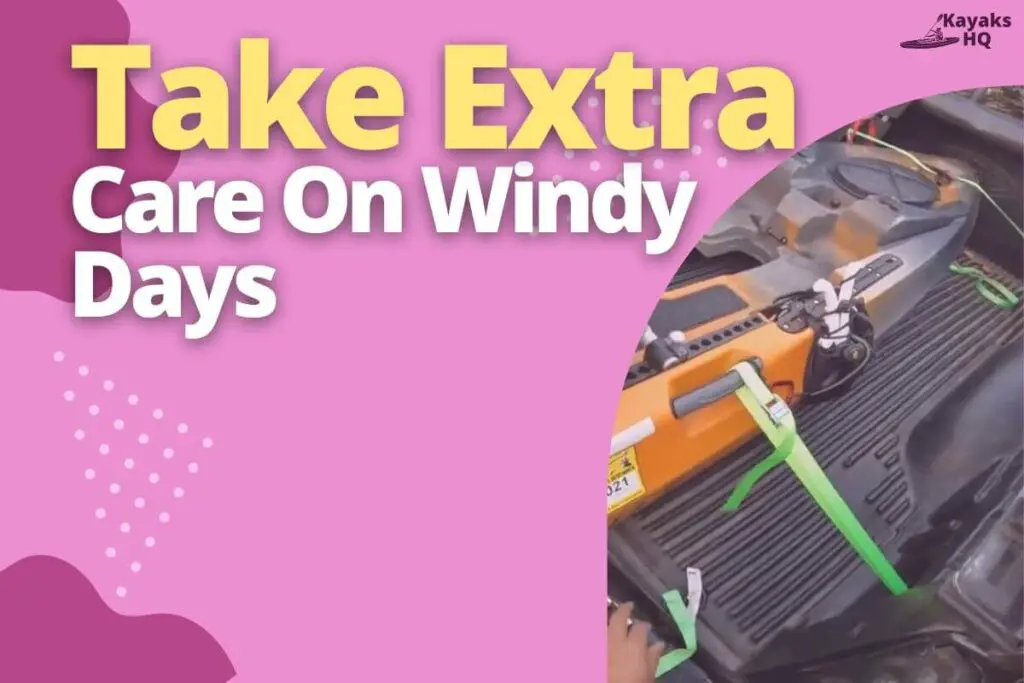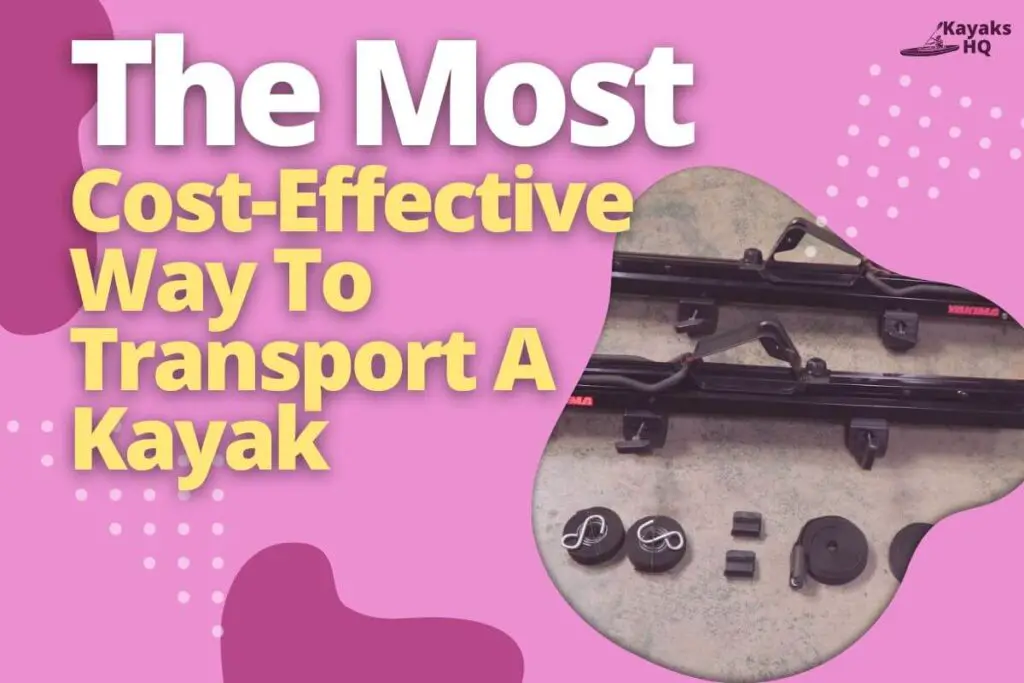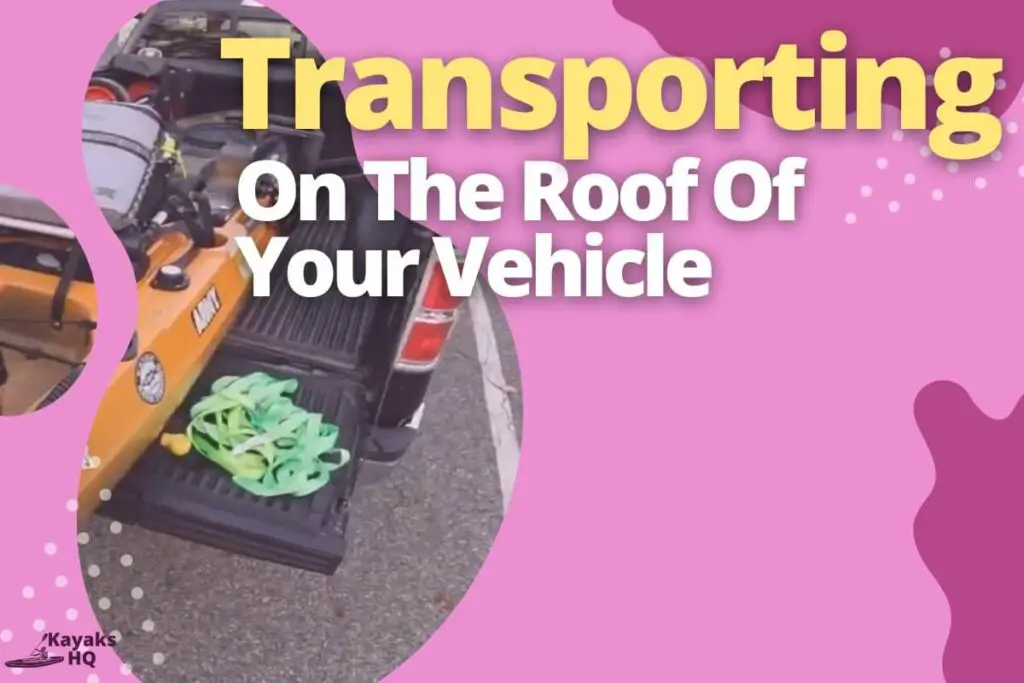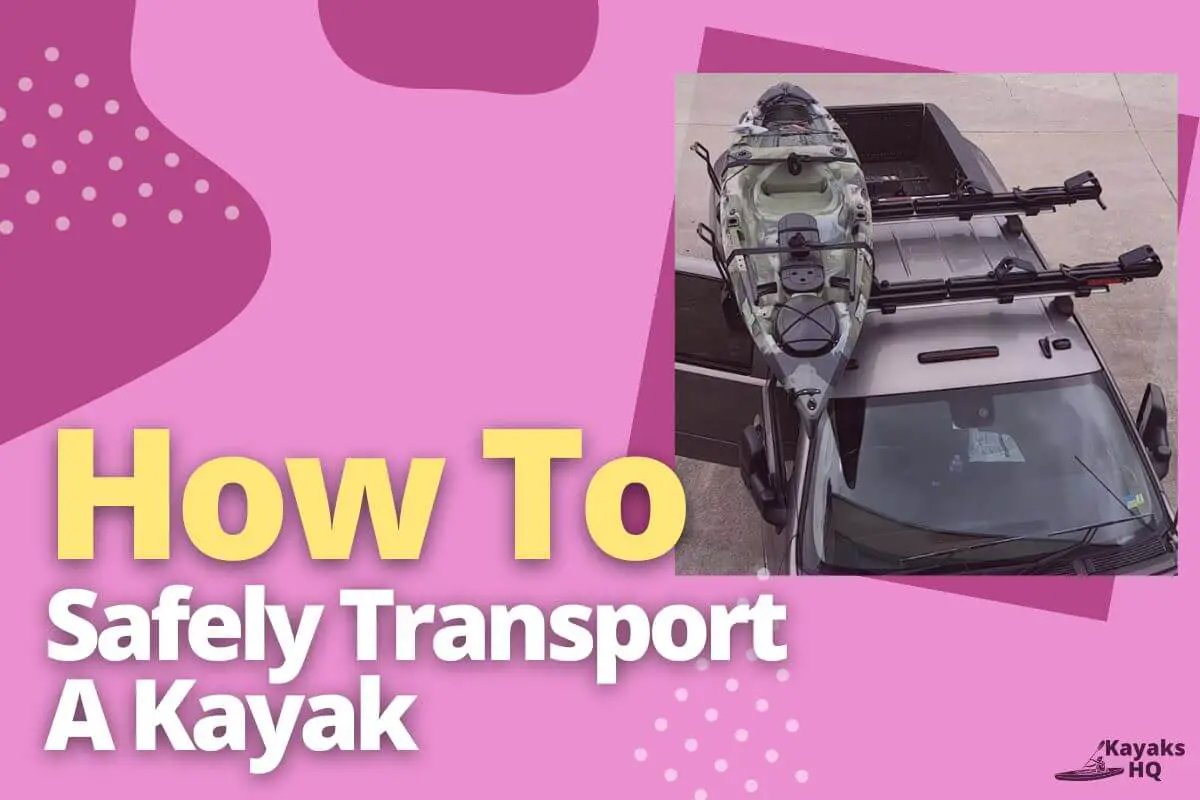Kayaks are incredibly fun. Whether on the ocean or on a lake, kayaking is a great way to get active, explore the world, and spend time with friends.
But even the most careful kayakers sometimes get hurt. And if you’re transporting a heavy kayak, chances are you’re going to get hurt.
That’s why it’s important to transport a kayak safely. In this article, I’m going to tell you everything you need to know in order to transport a kayak safely.

Here’s The Answer To How To Safely Transport A Kayak
There are a few different ways you can transport a kayak, but the most important thing is to make sure you do it safely. The first step is to attach the kayak to your car using a saddle, j-cradle, or other types of attachment.
If you’re using a kayak rack, you’ll also need to attach the paddle to the kayak. After securing the kayak, you can transport it by placing it on the roof of your vehicle or in the cargo area of an SUV.
If you’re putting it on the roof, make sure to use a roof rack system and tie the kayak down securely. If you’re putting it in the back of a truck or SUV, you can use foam blocks, pool noodles, or other materials to keep it from moving around.
Once you get to your destination, the last step is to safely remove the kayak from your car. If you’re lifting it off the roof, be careful not to drop it. If you’re removing it from the back of a truck or SUV, be careful not to hit the kayak on the tailgate.
A little forethought and organization will allow you to bring your kayak anywhere without worry. Just be sure to follow these tips, and you’ll be able to enjoy your time on the water without any worries.
Protect the edges to avoid damage and scratches
To protect the edges, you can use a padded strap or cover. Padded straps are a great way to protect the kayak’s hull and also help you keep it from being damaged while transporting.
To do this, you can use a regular strap with padding on one side of it. You should also get some padding for your vehicle if possible so that it doesn’t scratch your kayak along the way either.
To protect the cockpit, you can use padding as well—but make sure it is thick enough so that no scratches will occur when loading or unloading the boat!
Cover the kayak with a kayak cover
Put your kayak in a waterproof bag to keep it safe from the elements such as snow, rain, and dust.
Hard-shell kayak covers are the most effective means of protecting your investment. This will protect it from damage caused by UV rays and scratches, as well as keep it clean and dry – which means less work for you when you arrive at your destination!
Strap it securely with padded straps

To transport your kayak, you’ll need to strap it securely to the roof of your car. You can use a couple of ratchet straps, but they must be padded and long enough to snugly fit around the kayak and tie down at least two points on its hull.
The best option is a strap that’s designed specifically for transporting boats and other water vessels. It should be made from tough, durable fabric that won’t get frayed or torn like webbing straps might over time if used repeatedly without any protection against UV rays (which cause quick deterioration).
Other factors to consider when choosing a strap include:
- Length—The straps should be long enough, so they don’t slip off but not so long that they encroach on visibility while driving or parking; most models will come in multiple lengths suitable for different vehicles with varying roof heights.
- Width—A wider width provides more support than thinner ones do, making it harder for them to tear apart under pressure or strain.
- Thickness—Thicker straps are harder for thieves because it takes more effort/time/knowledge of how best to use tools effectively without damaging anything else nearby if there’s another car nearby.
Transport it in an upright position if possible
If at all possible, transport your kayak in an upright position. This will help keep the hull from being damaged by pressure on the bottom or sides of the boat.
If you cannot transport your kayak in an upright position, it is important that you place it on its side and secure it so that nothing shifts inside or out.
If transporting a single kayak, make sure to put enough padding around the boat so that no sharp edges can damage your craft or yourself when moving it into position.
Take extra care on windy days

The wind is the biggest cause of kayak accidents. It can cause your kayak to tip over, it can damage your boat and equipment, and can blow you off course. Thus, it is essential to use extreme caution in venturing out into windy terrain.
You should always be aware of your surroundings when traveling with a kayak on land or water. Pay attention to how winds are blowing and where they may be headed so that you can plan accordingly for your trip.
If there’s a chance that winds are going to pick up during the day, consider heading out early before the breezes pick up or waiting until later in the evening when temperatures have dropped back down again after heating up during the midday hours (and thus reducing air pressure).
Check the straps regularly
Kayak transportation can be tricky, especially if you are transporting it on your own. But there are a few things you can do to ensure that your kayak is safe and secure as you transport it.
Checking the quality of the straps is crucial for the secure transportation of your kayak. While paddling down the highway, the last thing you need is a loose or broken strap, which might do major harm to both you and your kayak.
To avoid this from happening, check all straps regularly for frayed edges, cuts in them, or anything else that might indicate they need replacing or repairing before using them again.
As an added precaution, double-check that each strap is snug enough to prevent movement during transit but not so tight that it causes discomfort or injury to you or anyone else in the vehicle.
Inspect the kayak before each use
- Inspect the kayak before each use
- Check for damage, leaks, and missing parts. For example, look at the hull of the boat to make sure there are no dents or cracks. Also, check that all screws are secure in their place so they won’t fall out during transport.
- If you’re transporting an inflatable kayak, be sure to check for any signs of wear on its valves or air chambers before you head off for your trip. Inflatable boats tend to be less durable than hard-shell ones since they’re made from softer materials like rubber or PVC plastic (polyvinyl chloride).
The Most Cost-Effective Way to Transport a Kayak

The most cost-effective way is with a roof rack or hitch-mounted rack. These systems are widely available at outdoor stores and on the internet and normally include everything you need to safely transport a kayak on the roof of your vehicle.
The downside is that they can be expensive and require some assembly, but if you’re planning on using this method regularly, they’re well worth the money.
Another option is to use a trailer or container (both available online). Trailers have wheels that allow them to be towed behind any vehicle.
Both methods carry several advantages: They’re affordable, easy to use; don’t require any installation; keep your back seat free, so anyone can sit there during short trips around town/home base.
What type of vehicle should you use?
In order to transport your kayak safely and efficiently, you need to choose the right vehicle for the job. There are several factors that will help you determine which type of vehicle is best for transporting your kayak:
- What type of kayak do you have? What size kayak do you have? If you said “yes,” keep reading because there’s excellent news in store. You can use any one of these vehicles below as long as it fits in the bed with room to spare around all sides (this includes any bumpers).
- What size car do you have? By knowing what size vehicle works best for transporting your kayak, then all that remains is finding out if it fits in your garage.
How much space will your kayak take up?
Knowing how much room you’ll need to move your kayak is essential.
To be safe, it’s best to double-check the dimensions for the width of your kayak, length of your kayak, and height of your kayak before making any assumptions about how much room you’ll need.
If you have a two-seater, for example, then this will obviously take up more space than a one-seater or a solo model. The combined weight of the boat’s occupants is something else to think about (not just people sitting inside).
Should you bring a trailer or container?
If you’re looking to transport your kayak or canoe regularly and don’t have a vehicle large enough to accommodate it (i.e., if you have a small car), then a trailer is the best option.
However, they can be costly and need a large storage room or garage. If you plan on using your kayak only occasionally, then a portable container might be ideal for you.
Containers are cheaper than trailers, but they’re also heavier and so harder to move around without assistance; this means that if you do decide to buy one of these types of containers as opposed to renting one, make sure that it fits into your car’s trunk before making any purchases!
Planning the transport route in advance
When it comes to transporting a kayak, you want to choose a route that is free of traffic and other obstacles. You must also check that your planned path will allow you to easily cross any bridges and tunnels.
You should check the weather forecast before setting off on your journey. While traveling with your kayak, make sure that there are no delays due to inclement weather conditions or poor visibility.
When planning the transport route in advance, consider where your vehicle will be parked at both ends of your journey. This could mean finding parking spaces near where you will launch and/or land or even calling ahead if necessary so as not
to have any surprises once it’s time for unloading or loading onto another vehicle (i.e., pickup truck).
Transporting on the roof of your vehicle

Before you start transporting your kayak, consider what type of vehicle you have. If it’s a car or SUV, where the kayak will be stored on the roof is probably not an issue.
Transporting a kayak, however, may present some difficulties if you drive a pickup truck or van (and especially if you use a cargo camper).
If this is the case for you, we recommend getting a roof rack for your vehicle that has bars spaced far enough apart so as to not interfere with the opening and closing of the doors while they’re in place.
Cargo crossbars lie atop these racks, which are typically composed of a steel (like kayaks).
The crossbars should also fit snugly behind each other when closed so as not to allow any room for movement during transportation by road or highway speeds.
Transporting in the trunk of your vehicle
In order to safely transport your kayak in the trunk of your vehicle, you must first ensure that your vehicle has a trunk. If it does not, this guide is not for you.
In order to protect both the kayak and those who will be transporting it with you, place a blanket or pad over the inside of your vehicle’s trunk.
This will keep any scratches or dents from happening during transit (and hopefully protect anyone riding in the back).
It’s also important that anything else being transported (such as bicycles) be placed on top of the blanket/pad so that they don’t scratch up the inside of your vehicle’s interior when placed next to each other after loading up everything else into their respective places within said trunk space.
Unloading the kayak at the destination
- Make sure you have a safe place to unload. If at all possible, put down a few beach towels or something similar under your kayak and use that as an area to rest it when you get off the water. This will protect your kayak from rocks and other sharp objects that may be on the ground or in the sand, which could potentially damage it if they’re dragged over them.
- Don’t unload the kayak on a slope. If you have to unload at the top of a hill and there are no convenient flat surfaces around, consider using logs or large rocks as mats so that you can roll your kayak onto them without having any part of it roll down into dangerous territory below (like between two boulders).
- Don’t unload in an area where it could tip over. If there are natural hazards like tree stumps nearby and/or steep drop-offs down below where you want to set up camp for dinner or just anywhere else where tipping over is possible, try not leaving any part of your boat sticking out over those areas when setting up camp!
What To Do If Your Kayak Tips Over
If your kayak tips over, don’t panic. Instead, focus on getting yourself to safety. Do not try to right the kayak by yourself if it’s heavy, and do not attempt to re-stack your kayaks if you are unsure of how to do so safely.
If you are alone and fall kayak is heavy, don’t try to lift it back on with no other assistance. Call someone immediately and wait for emergency services to arrive at your location.
When should you call emergency services?
If you are severely injured, if you are in a remote area and need help, or Call 911 if you’re in a dangerous position and need to get out of there quickly.
In cases where doing anything else would be too risky or impracticable, this is a fantastic alternative. If you are transporting your kayak through water that is known to be plagued with deadly critters, you may want to think about calling 911. (e.g., sharks).
Conclusion
In this blog post, we outlined some steps you can take to ensure that your transportation in a kayak is safe. First, you want to make sure that the kayak is properly secured; we showed you some different ways that you can secure it.
Make sure you have the equipment to safely move your kayak before attempting to do so. Also, be sure that you have a bag that is waterproof and can protect your kayak from the rain.
Your kayak can now be transported safely, so long as you remember to follow the transporting guidelines. You can transport it in a number of different ways, depending on the size and weight of your kayak.
In this blog, we have shown you the most common methods of transporting kayaks. Be sure to check back for more blog posts on how to transport a kayak.
Thank you for reading, and be sure to check back for new topic posts.

